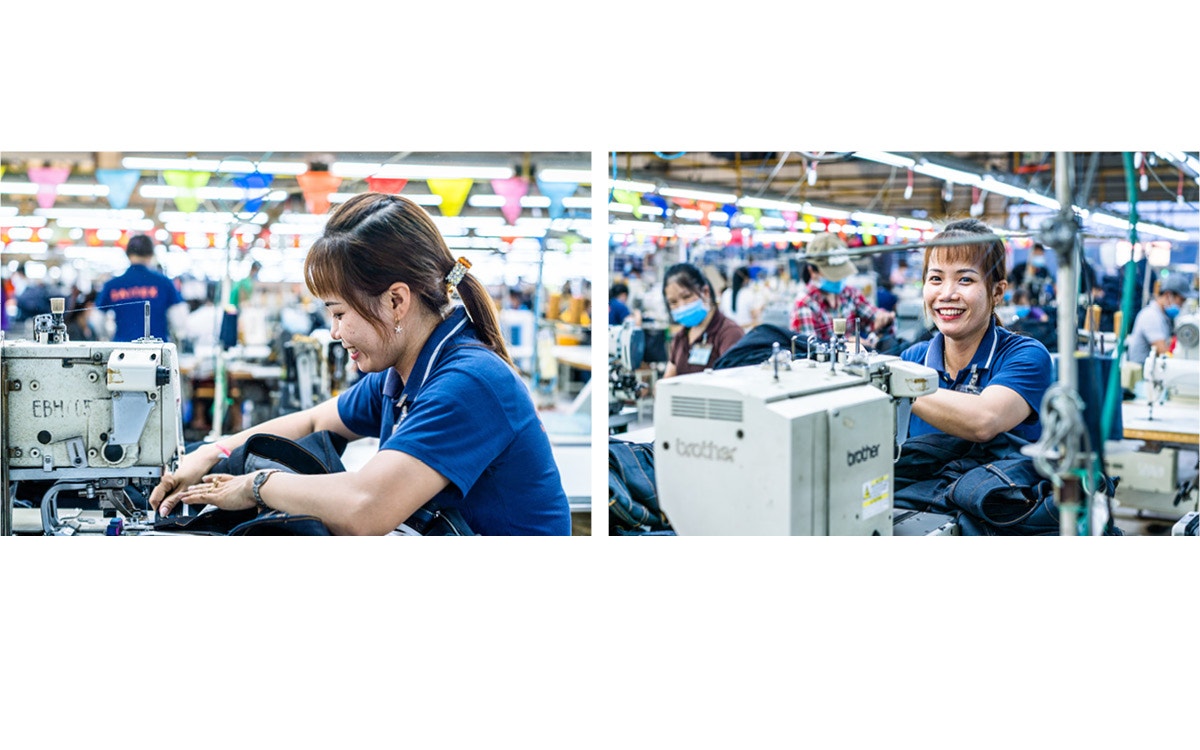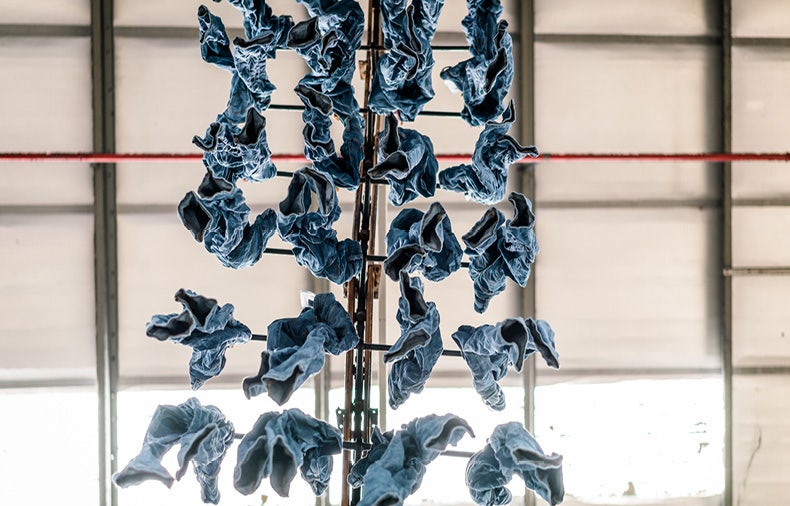In Vietnam, Don Rowe meets a man on an extraordinary mission.
Photography by Quinn Ryan Mattingly.
Behind a glass screen 30 kilometres outside of Ho Chi Minh City, a pair of suspended blue jeans are gently smoking. The plume moves smooth and serpentine across the left leg, then the right, leaving stylised bleaching as it goes. The plume starts again, moving top to bottom this time as a laser traces a pre-programmed pattern of distress and fading. A technician reaches into the cabinet, removes the jeans, and they disappear onwards to shipping, headed worldwide for brands like Calvin Klein, Ralph Lauren and Barkers. It took one minute, and only a single glass of water. The seven lasers here will produce 1200 items each, every day.
Saitex factory founder Sanjeev Bahl speaks softly. “This enterprise is a tool and it’s been given to us for a purpose.” Bahl wants to save the world. It’s the redemption of denim, one pair of jeans at a time.
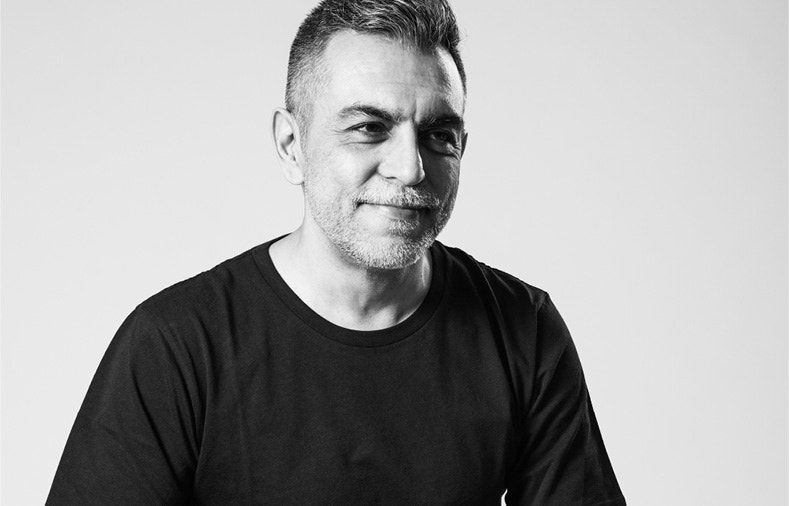
Fast fashion notoriously takes a severe toll on both the environment and the droves of workers bent over their machines, spray guns and washers. Names like Rana Plaza are synonymous with the deaths of thousands of employees burned, crushed and poisoned. Luckier workers face a continually decreasing quality of life, as their mental and physical health deteriorates under the harsh factory lights.
Denim production is particularly problematic. In denim-producing nations like China, Sri Lanka and Bangladesh, toxic indigo sludge chokes the life from rivers and streams, hastening our worldwide climate death spiral.
In this grim context Saitex is a maverick, a revolutionary. It’s changing the game. But from the outside it looks like just another factory. It sits 30 kilometres from the CBD, in a vast industrial park alongside brands like Nestlé, Red Bull, and YKK. Ho Chi Minh is in a boom, and the roads have the air of a construction site: roaring lorries screaming down packed lanes, mopeds swarming like mosquitoes and just as fragile. But in the park it’s quiet and mostly empty. The real hustle is inside.
Mohamed Amein, a gregarious Tunisian in a premier league shirt, is holding me firm by the bicep. We’re high above the factory floor. In an adjacent room technicians in white coats worry over patches of denim, here testing, there stretching, applying solvents and detergents. Amein directs me to a table upon which sit three glasses of water. On the left is an indigo nightmare, in the middle something resembling gutter rain, and on the right is perfectly translucent water.
“Here, you drink it,” he says, passing me the filtered glass.
It tastes like the inside of a hose – but not poisonous. The denim-dyed vial on the left is sludge; a toxic run-off of the manufacturing process as raw denim is washed and washed again. In the middle, the water has been pulled through a membrane to remove the sludge, which will be mixed with cement and water to create bricks. Saitex have used those bricks to build three orphanages so far.
“Ninety-eight percent of the water in this factory is recycled,” says Amein. “And the other two percent evaporates. After it rains, I will take it back.”
Outside the room, at eye level, hundreds of jeans are hanging from the roof, swaying slightly in the rising heat. It’s 55 degrees beneath the ceiling, a full 20 degrees more than on the factory floor, and the jeans will be done in three hours. Eighty-five percent of the products here are air dried, saving upwards of 13 million kilowatts of energy a year. The remainders are steamed with the heat from burning recycled wood pallets – at double the price of electricity.
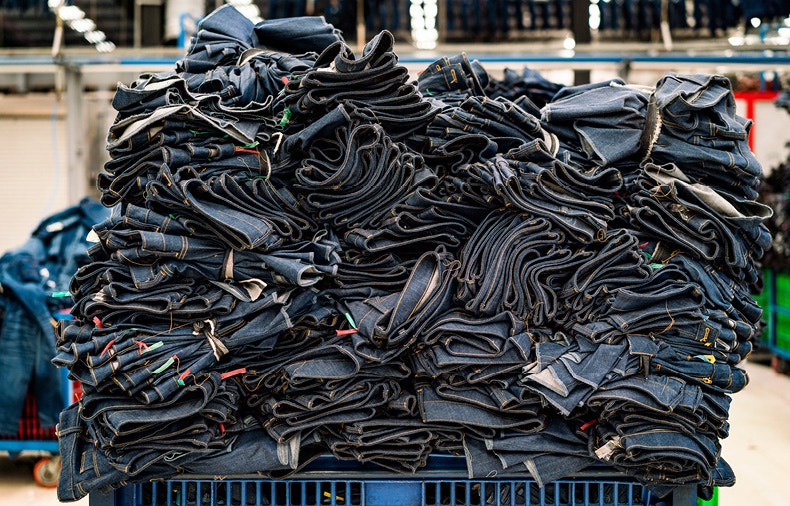
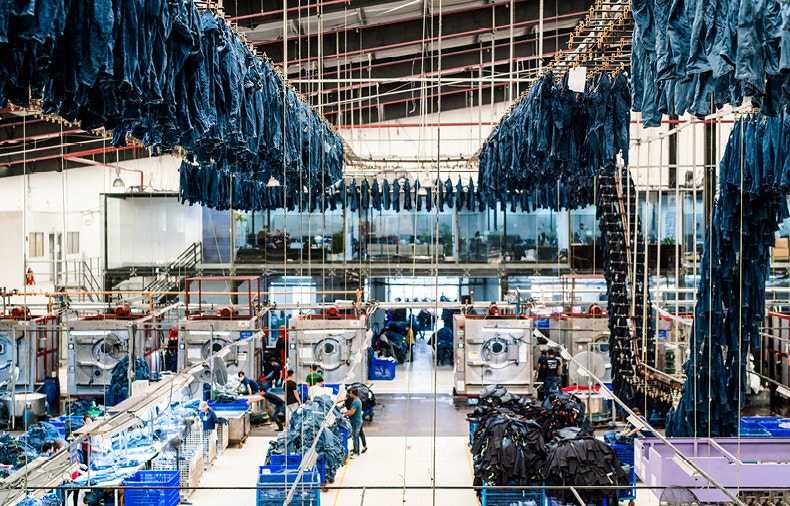
“My grandmother at home hangs her clothes to get them closer to the sun,” Amein grins. “She’s not wrong.”
The man who drives this innovation – this determination to do things differently, and do them right – is Sanjeev Bahl. So what’s driving him? “I went to a Catholic school in India, my best friend was a Muslim, and my mum she had a little Hindu temple at home,” says Bahl, sitting in his office, with his hands folded neatly over a black tee shirt. Bahl is slight, calm and quietly sardonic, with an air of George Clooney about his features.
“As I was growing up I had a deep respect for all religions but I was searching for something beyond religion. I wanted spirituality. And in my search I got completely attached to [19th century teacher] Sai Baba. He expired in 1918, but what he taught were very simple things.”
Sai Baba taught from a mishmash of Muslim, Hindu and Buddhist texts. He preached tolerance, patience, and moral action. He condemned orthodoxy, and criticised the love of impermanent things. He became Bahl’s spiritual guru and Bahl, who meditates daily, says his practice has shaped every facet of Saitex – itself named after the guru.
“It was all about self-realisation and it was all about feeding people and doing good and it’s very similar to Buddhism,” he says. “Don’t do harm to others and have a lot of patience and perseverance and to keep going for the right things. I think that resonated with me in a way. And then there’s always this power, right, which you feel when you meditate. I just feel very connected and extremely grateful for all the lessons I have learned through spirituality.”
Human history weighs heavy on him, too. In the lobby there’s a shrine to Sai Baba. Opposite is a wall lined with helmets, some riddled with bullet holes and graffiti scrawled by Viet Cong and American GIs. “Drop the atomic bomb on me,” reads one.
In Bahl’s office is a framed copy of the New York Times from October 28, 2018. Tiny Yemeni girl Amal Hussain lies emaciated, her face turned away, skin stretched and waxy like peking duck. Bahl stares at it for a long time before turning to me. “I think we feel as a human, we are all so bottled up in our own countries and our own boundaries and it’s all about our own comfort. We rarely look outside and see how much suffering there is on this planet.”
“That photograph reminded me and keeps on reminding me how futile and useless war is. Human beings and their ideologies, everybody has their point of view which scales up into conflict, but when people get into conflict they don’t realise the pain that they create all around them. It was really difficult but I decided to frame it and keep it so that it reminds me every single day that we have a broader and larger vision.”
I think about that later as I walk the halls of the Remnants Museum in Ho Chi Minh, itself a horrific reminder of the futility of war. In that museum there are rooms of photographs of corpses, of destruction, of GIs carrying Vietnamese turned to dessicated frames like grotesque deli items. In the lobby are distorted children in wheelchairs, living testaments to the ongoing effects of the chemicals Americans deployed on Vietnam – grotesque tragedies with no justification.
Outside I sit briefly with a woman, her skin pale, cracked, run with red flakes like dried sand. She has no lips. I turn away. Further, outside Saigon Square, a market in the central city, a young girl sits with a tongue so bloated it forces her mouth open, and her gums are so swollen that her teeth are just tiny protrusions like seashells in meat-sand.
The destruction and revival of Vietnam weighs heavy on Bahl, who was called crazy for moving production here when Mauritius, Sri Lanka and Bangladesh are so much cheaper. The apparel business is migratory: production generally follows the lowest costs. Companies make little investment in their people or plant, cognisant always of the temporary conditions and uncertainty. Usually, it’s the workers who suffer.
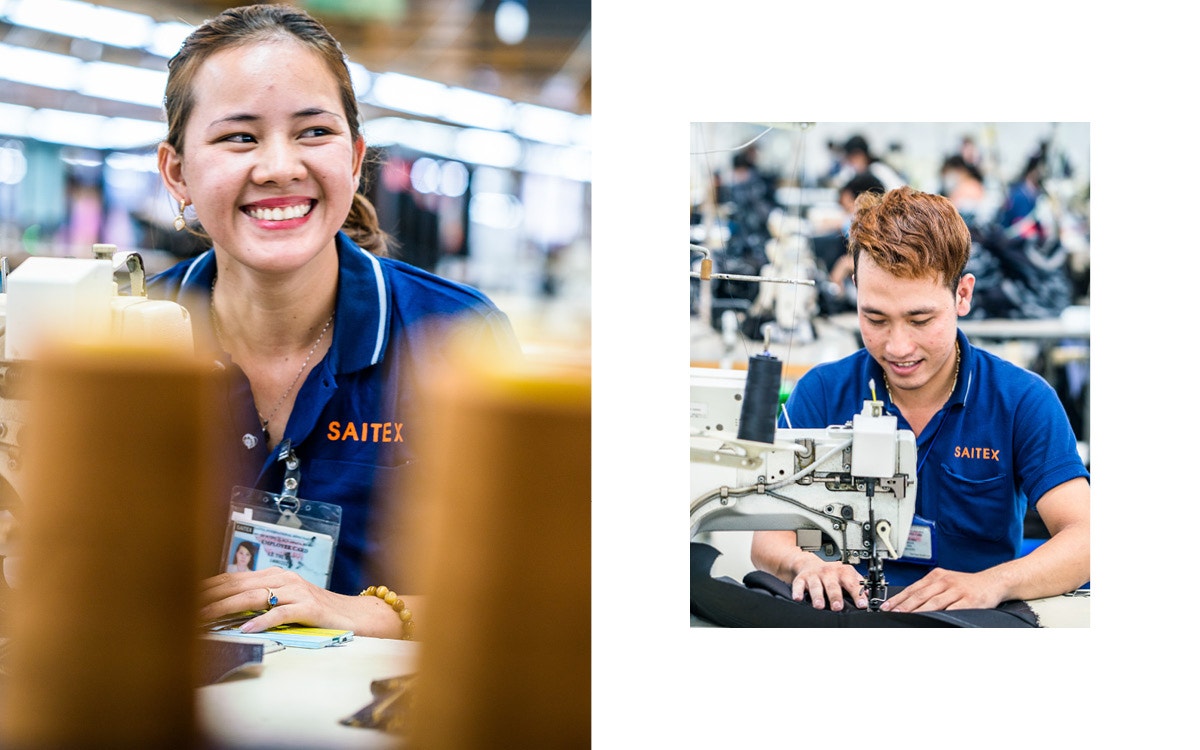
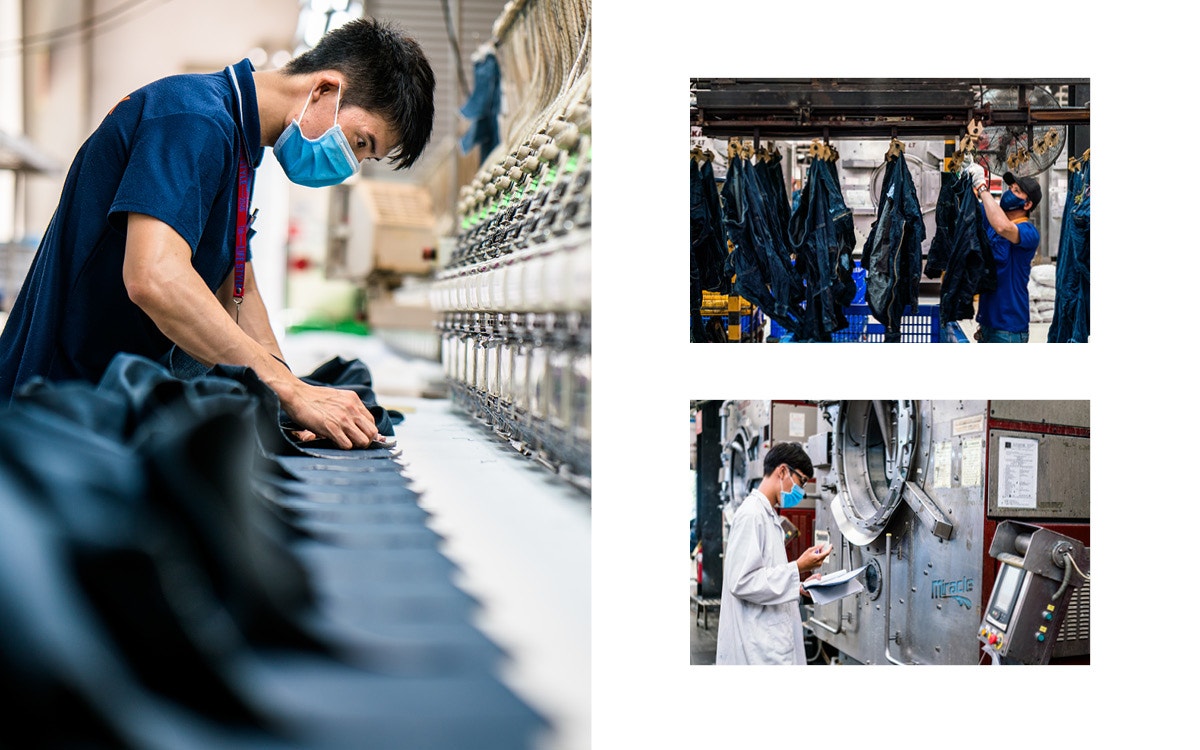
“Through my travels I could see modern day slavery, I saw abject poverty in a lot of places, inequality, mental damage, inadequate sanitation – it’s all bad,” says Bahl. “I didn’t want to participate in that economy, and so what was always in my mind was that when we build our own factory, we build it the opposite of what I’d seen. That was the real reason to do things right, and not to continue on that path of destruction. That was the mantra. Only later did sustainability become the big buzz word.”
But Bahl, who insists he hates the word itself, has a very clear idea of the financial upside of sustainability. We run through the facts. The investments Saitex made into water recycling paid themselves off in less than six years. The shift in drying techniques again paid themselves off in six years. In Dubai, an entire Louis Vuitton store is made with panels of recycled and varnished slabs of Saitex denim. Soon Ikea will sell tables made of the same. Recently, a collaboration with Puma which recycled denim scraps to create shoes raised US$250,000 at zero cost, funding the construction of the fourth Saitex orphanage, which together house upwards of 800 children.
“They can live there with dignity,” he says. Posters dotted across the factory grounds preach religious acceptance; Bahl’s employees are from Europe, the Middle East and Asia – a total of 15 nationalities. Where other factories can treat staff as disposable, it’s clear that at Saitex the focus is on the long term.
And here’s another box ticked: Saitex was recently certified as a fair trade business, and muscled brands like J Crew and Target to join too.
All these stories have significant marketing value in the age of the conscious consumer.
And so, in an effort to connect customers to the story of their product, and to prevent Chinese counterfeits, Saitex developed a thread-tracing technology. Using a custom-made scanner – a Bluetooth version is in the works – consumers can pass a sensor over the garment which detects a molecule in the thread. First it verifies the authenticity, and then has the capacity to send customers to a website, app, or video.
“With everything that you make, there is waste, so we started looking at every possible form of waste we generate, and how could we turn it into a profit,” says Bahl. “From waste we created social impact, we created financial impact, and we created environmental impact. It had nothing to do with the cost. But profitability is important. If you don’t have profits you can’t do all these things – let’s face facts. You need to balance and measure everything.”
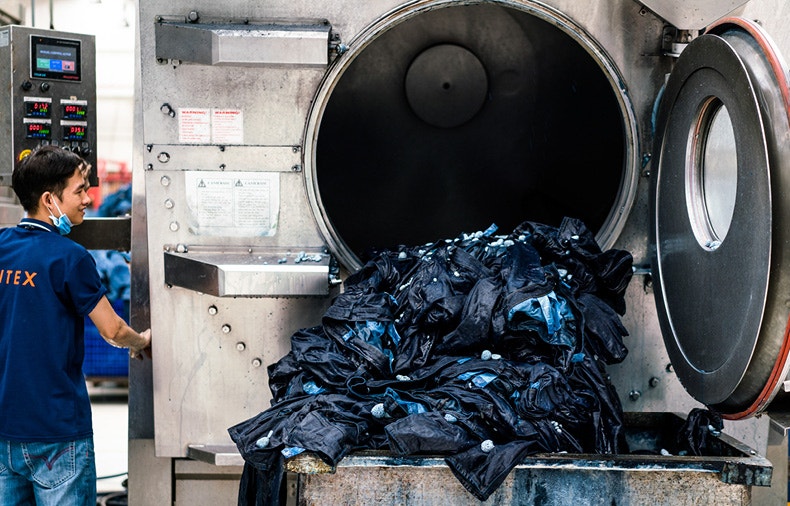
Now that Saitex is in the black they’re utilising that cashflow to gift electric bikes to the workforce – 18 percent of Saitex’s carbon footprint comes from the 4,500 motorbikes in the organisation. Bahl says there’s a double impact: it helps workers to reduce their costs in buying gas, and will enable the organisation to achieve carbon neutrality by 2023.
All this amounts to a drive to become a B Corporation, joining the likes of Patagonia as one of the few apparel companies in the world to meet the strict social and environmental impact criteria of the standard. The distinction is proof of an audited commitment to sustainability, and serves to attract green investment and credentials. Before the end of the year Saitex will have their own operational mill, 25 acres – fully 15 times the size of the laundry – with capacity to grow organic cotton and food to feed thousands. Then comes the giving back.
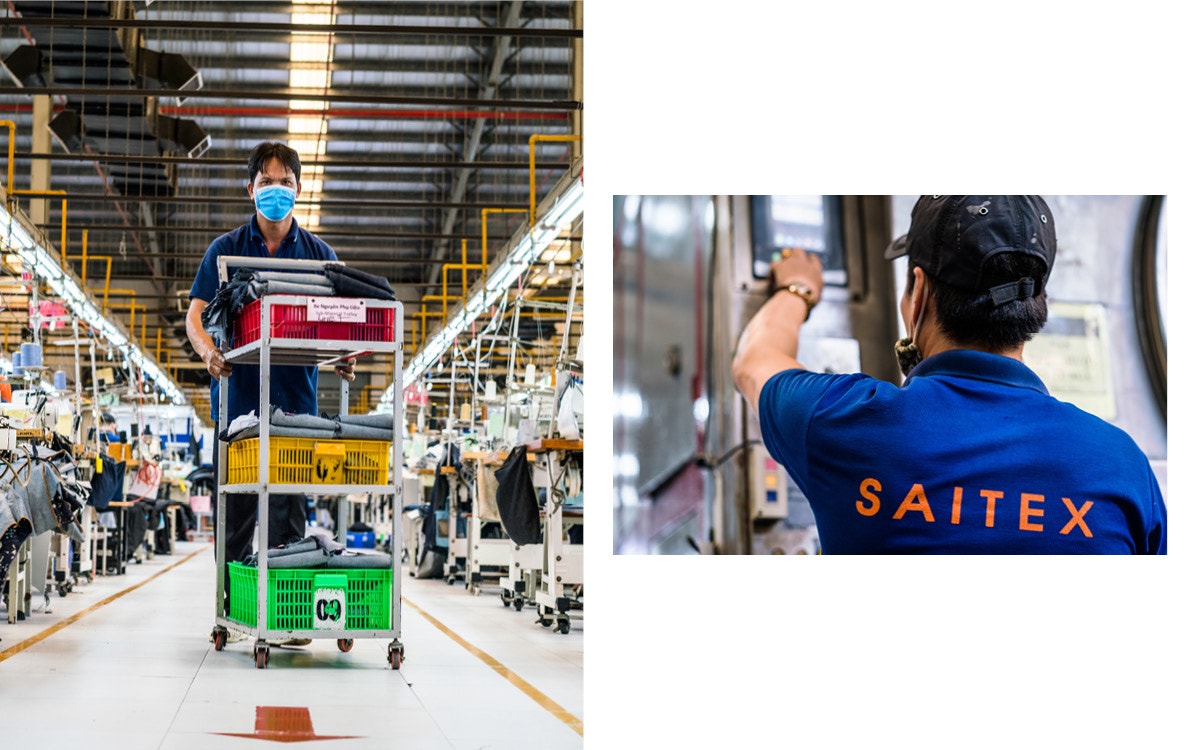
Sanjeev Bahl is pensive. He’s seated across from me, cupping his chin and resting an index finger over his mouth. From time to time he begins to speak then halts. Finally he leans forward, looking me unblinking in the eye.
“You know, anger is not useful. What can you do with anger? You can’t change the world with anger. When you look at these things, climate change, war, famine, do they have impact on me? Of course, of course it impacts me. But does it make me angry? No, because if you look at the universe, there are so many questions with no answers. So do something about it.”
In a shipping container across the street, a row of basil plants hung vertically from the ceiling reflects the blue and red glow of hundreds of LED lights. It’s cool inside. There is refrigeration, and even speakers. This one scalable box can grow as much food as three acres would outside. The plan is to distribute the produce to the orphans cared for by Saitex. It’s a solution – maybe – to one of Bahl’s obsessions.
“I think food is really, really important. Food and water. I would not like to see in anybody’s lifetime wars being fought over food and water. I’m always looking at 2050, and I keep on asking myself, I keep painting a picture of how this planet will look – you don’t have to be a nuclear scientist to figure that out.
“We have 7.2 billion today, let’s say by by 2050 we have nine billion, you’re talking about a 30 percent increase of human beings on this planet. With every one degree of change in temperature you’re talking about massive upheavals from climate change and intense climate action. We will have food problems, water problems, climate refugees.”
He has a more personal interest in farming too: his son, 16 years old, is autistic. And in the United States, where they live, there are very few tools available for people on the spectrum above the age of 21. Bahl sounds emotional for the first time.
“One out of every 250 children born today are on the spectrum. The problem is not small. It’s huge. If you look at the parents of these children, I guess everybody has a single fear: what’s going to happen after I pass away? On a farm you have repetition, nature, animals and horses, that environment to give them a life. Through this farming mechanism if I could create a cooperative movement that could help these kids once they turn 21, I think we would be able to reduce the pressure and create hope.”
“It’s really important that every day we do what we have to do, and we don’t contribute to destruction. That’s the only thing I’m focused on.”
In a frequently exploitative industry, one that so often has devastating outcomes for the environment and for the people who drive the bottom line, Saitex is proving every day there is a better way. And it starts with caring.
As the smoke of endless thousands of cooking fires rise above the darkening streets, and the sun hangs overripe, blood red like it’s ready to drip syrup on to Ho Chi Minh, Bhal’s words stay with me between the screaming lorries, now heading home.
“Look down not up, it fills you with gratitude,” he says. “Once you recognise that, and you live your life like that, there is contentment and there’s peace.”
